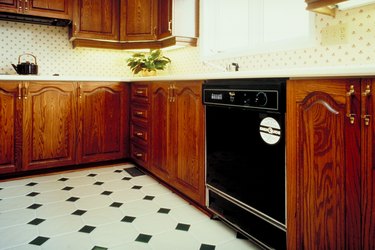 Properly prepared linoleum flooring can support new self-stick tiles.
Properly prepared linoleum flooring can support new self-stick tiles.
Self-stick tile, also known as peel-and-stick tile or self-adhesive tile, can be a do-it-yourselfer's best friend, saving money and mess on sticky adhesives when laying a new vinyl tile floor. As with all tile installations, preparation of the subfloor can easily determine the success or failure of the project. Self-stick tile can be laid over linoleum only if after proper preparation.
Video of the Day
Linoleum Requirements
Even with its smooth finish, linoleum can support self-stick adhesive tile as long as you take the time to inspect and prepare the surface. First, the linoleum must be completely secure and structurally sound. If any part of the material is peeling, cracked, broken or un-stuck, the material is not suitable for installing self-stick tile. You must perform a thorough inspection of the surface to ensure you are not dooming the self-stick tile application from the beginning. If there are any structural issues, or if the linoleum is in need of any repair work, attend to that before installing self-stick tile.
Cleaning
The linoleum floor must also be completely clean before supporting self-stick tile. Any contaminants on the surface, including dirt, dust, grease, wax oil, paint and old finishes, will react with the adhesive on the back of the tiles. Depending on the contaminant and the adhesive, this could lead to serious changes in the speed at which the adhesive cures, potentially leading to loosened bonds or shifting tiles due to extended curing time. Wash the entire area with mineral spirits, a solvent cleaner that will remove all contaminants, then rinse well with clean water to remove solvent. Towel-dry the area or allow it to air dry completely before attempting your installation.
Leveling
The final requirement for a linoleum subfloor is that it must be completely level to support new self-adhesive tile. Because linoleum doesn't feature grout joints or other uneven fixtures, this should not be a problem. You should still run a level across the surface, however, to double-check for gaps or rises. If any area of the floor varies from the overall level by more than 1/8 inch, it should be filled with filler putty or ground down with a floor grinder. If you install self-stick tiles over an uneven surface, there could be gapping or cracking that will spread outward, potentially damaging the entire installation.
Roughing Up
Read and follow all installation instructions and warnings that come with your peel-and-stick tile before begining installation. Some manufacturers may require you to roughen up a smooth, glossy floor like linoleum to ensure the adhesive has some texture to stick to. In general, you can do this with sandpaper or a floor grinder. The project should include only fine-grit grinders or paper, since you only want to roughen the surface, not remove it.


